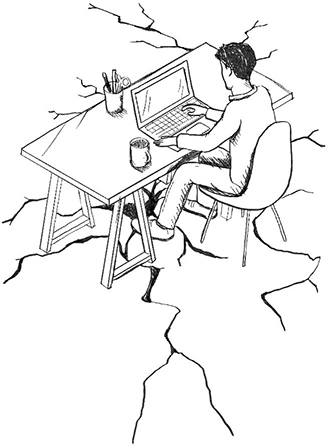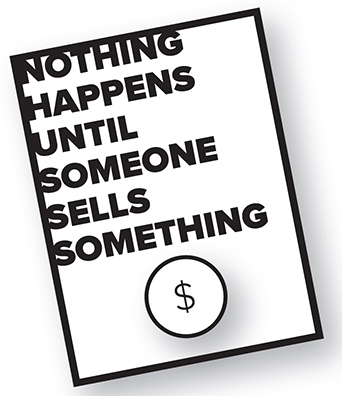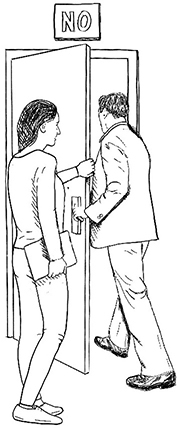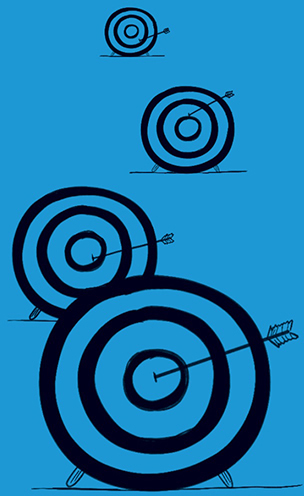five
SALES
By 2012, things were looking up at Okta. We’d pulled out of our death spiral and had started to win a bunch of contracts. We were finally offering a product that fit the market. I began to feel good: we might actually survive.
So I was floored when things went south again.

I had flown to Louisiana to make a final pitch to a company there, and it had gone great. The deal was going to propel us forward, and I knew we were well positioned. I asked who we were competing against, and when they told me, I smiled smugly.
“That’s great,” I said. “We love competing against them because we beat them every time.” Two weeks later, the prospect called and said they’d given the contract to our competitor.
“You sure you dialed the right number?” I said, flummoxed. “You should be telling that to the other guy.”
“No, I dialed the right number,” the executive said sharply. I felt a knot in my stomach and got off the phone. I couldn’t believe we’d lost.
The next day, I called the prospect back. I wasn’t trying to change his mind. (Who am I kidding, of course I was!) But I also wanted to know why he’d gone with the competition. “You were too arrogant,” he said bluntly. “This is a new technology, and we’re going to have to work closely with the winning company to implement it.” He said he didn’t like our attitude. “We thought you’d be a bad partner.”
It hurt, but I needed to hear it, as did my whole team. Being aggressive is fine. But, unfortunately, we’d also signaled we weren’t listening. The loss led me to change the mentality of our sales group. We needed to focus on partnership, not bombastic pitches. It took a while, but once we reoriented, our sales started to accelerate.
![]()
Sales is a complicated topic, and there are entire books that cover it. In this chapter I will focus on enterprise sales, which means selling to companies and government agencies, often very large organizations. It’s very different from consumer sales, but it’s what I know best.
I’m going to talk about some of the most important things I’ve learned about selling to other organizations, like how it’s a people-to-people business and how you must focus on building relationships above all else. I will explain why you, the founder, need to stay extremely close to your sales team. I will share some tricks about how to close deals and about how you must go above and beyond to make your first customers extraordinarily successful.
For some of you, sales will be a new experience. Some will find it awkward. Others might even find it distasteful. But for a founder, it must become a way of life. I hope you get to the end of this chapter and feel more empowered. If your stomach starts churning, however, pay attention. Sales is the foundation of your business. As I said in the Introduction, “nothing happens until someone sells something.” Unless someone buys what you produce, there is no business. You don’t get to work on your idea. You don’t get to grow. And you definitely don’t get to IPO.

![]()
People Buy from People
Exhibit A in why relationships matter.
About that blown deal I mentioned earlier: it has an epilogue. Another company came along soon after and did end up becoming our customer. It was a business in Boston. The deal was worth a lot less than the Louisiana one, only about $30,000. Though it wasn’t a huge amount of money, I still ended up flying across the country to walk them through the product. They agreed to do a paid test run, which worked out great, and I flew back to Boston to check in on how things were going. A little while later, they called and told us we had a deal.
Much later, one of the company’s executives explained to me that we had been competing for the deal with another company, also based in San Francisco. “Your product worked fine,” the customer told me, “and the other guy’s product worked fine.” So why did they go with Okta? “Because you came in person to see us—twice.”
Sales really are all about relationships. People buy from people. When you buy commodities—be it pencils or duct tape—that’s just transactional. It’s impersonal. You, the customer, know what you want. You find someone who’s selling it. You place an order. You get your purchase. There’s no interaction with another person.
But enterprise sales are different. They’re time-intensive. You have to invest hours, days, and months persuading your prospects that your product is something they want and can trust. With some companies, you only have to work with a single person. With the largest organizations, however, like those in the Fortune 500, you could have 2, 3, or even 10 different people to convince. Some will be fans who will help you move through the organization. Others might resist. Some do so simply because your product threatens some part of their fiefdom. You have to spend time trying to downshift their objections enough to get the sale, even if you never turn them into actual supporters. By definition, you need to build relationships with those people the same way you do with the fans, and it’s how you nurture and handle those relationships that often makes the difference in whether you get a deal or not, as well as how big it is and how fast it grows. The team at that Boston company decided to buy from me because they had met me and they had confidence in me.
The last reason for building relationships is that the individual executives who buy from you today will move to other companies. If you do a good job of creating a relationship with them now—and of proving, over and over, that you’re awesome at listening and serving their evolving needs—they will continue buying from you at the next two, three, four companies where they work.
The Two Books You Must Read
No matter what kind of selling you do, mark these words.

How to Win Friends and Influence People by Dale Carnegie
Sure, it was written nearly a century ago, but it’s as useful today as it was back in the 1930s. Nobody explains better than Carnegie what succeeding at sales is fundamentally about. It’s not about what you want to sell. It’s about what other people want to buy.

Little Red Book of Selling by Jeffrey Gitomer
It covers the most high-level principles about sales that you should know, especially in the early years of your company. Okta does more than $1 billion in annual revenue these days, and we have hundreds of sales reps around the world. But even with that big a team, I’m still constantly on the phone or in meetings with CEOs and CIOs who are considering using our products. You really never stop selling.
![]()
Scare ’Em with Scarcity
Another litmus test for customer seriousness.
Your first big deals are going to feel like they’re make-or-break. And they kind of are. You’re going to feel like you’d do anything to make them work: come down on price, give your prospect extra product, show up at their homes and shine their shoes for a month. But don’t give in to that impulse. In fact, do the exact opposite. First, do your homework. Make sure your prospect is a serious potential customer. Then, after you’ve gone to see them, demonstrated the product, discussed how they might use it, and sketched out the beginnings of an implementation plan, introduce the Scarcity Argument.
Here’s how Carl Eschenbach, who led VMware from 200 to 20,000 employees and grew sales 100× from $40 million to $4 billion, puts it: “You tell the customer with conviction and confidence that, ‘Listen, I don’t have a lot of resources to do implementations right now. We have a massive amount of customers interested in this, and I can only focus on the biggest ones. If you’re not serious about this, it’s OK. We’ll come back at a later time.’”
It’s not that different from nailing down a contractor to remodel your home. If you want a good one, you have to work according to their schedule. In this case, it’s reverse psychology. You tell them you can take them on now, but given how many people are closing deals, you might not be available in a month. Take Carl’s word for it. He’s now a successful venture capitalist with Sequoia Capital and sits on the boards of Zoom, Workday, Palo Alto Networks, and Snowflake, among others. “I have seen this work so many times,” he says.
Get Ready to Sell
A few basic principles for identifying and wooing your target customers.
1 Don’t “Spray and Pray”
While enterprise products are usually intended to be used by large companies across many industries, smart startups begin by targeting just one or two sectors. The specific needs and use cases vary too widely across industries. It’s hard to master them all immediately. Plus, your product will be a more obvious fit for certain industries than others. Start by choosing the industry that seems to be the best fit or has the most potential. Go after prospects in that field, focusing (if you can) on the top three or five companies. These are called “lighthouse accounts.” If you can win them, you can often own the whole vertical. Smaller companies in any industry often follow the top dogs, including buying the products they buy. Once you have a foothold in that vertical—and plenty of proof of how great your system works—start thinking about expanding into a new industry.

2 Find a Champion
Large companies are complicated organisms. You won’t be able to close a deal without an ally on the inside pushing for you. This person is your internal advocate, making your case to other stakeholders who need to sign off on the deal. They know how to navigate fiefdoms and politics. They likely have a sense of major initiatives within the company that could benefit from what you’re selling. And they have a level of credibility that you, as an outsider, do not.
Aneel Bhusri, cofounder of Workday, talks about how he was able to connect with the CIO at Chiquita Brands. Like Okta, Workday was an early mover in the enterprise cloud.* When Aneel started the company, many businesses were still unconvinced by the cloud and stuck to their on-prem tools instead. The CIO at Chiquita, however, understood where things were headed. Over a steak dinner in the Bay Area, he told Aneel and his team, “I know this is the right direction, and I’m willing to bet on you.” It was Workday’s first big deal—but not their last—with that CIO. He later moved to two other companies, including a multibillion-dollar consumer products firm, and he’s brought Workday with him to each one.
One caveat is to make sure your champion is a real champion, and not simply a “coach.” A coach is someone who’ll give you advice about how to navigate his or her company. A champion is someone who has the power—and the interest—to make the case for you when you’re not there. I made this mistake with the Louisiana deal. Part of why I thought the deal was in the bag was because I thought our contact was a champion. In reality, he turned out to be more of a coach. He was happy to help us, but he wasn’t in a position to go to the mat for us. When a more senior colleague in another group decided that we wouldn’t be a good partner, our coach didn’t have the juice to get us the win.
3 Don’t Promise Your Product Can Do Things It Can’t
It’s tempting to nod your head when a customer asks if your system has certain features, and then rush home and try to figure out how to make them happen. But it’s not a good idea. First, unless it’s a very simple feature, Murphy’s Law will probably bite you in the rear. Second, a prospect will call your reference customers and can easily discover if you’re lying. Lastly, and most importantly, you actually gain more credibility with customers when you’re candid about what you can and can’t do.
Fred Luddy of ServiceNow tells a story about trying to make a deal with a very large international bank that asked if his software had certain capabilities. “We didn’t just tell them we couldn’t,” Fred says. “We told them we had no idea how to do that.” Being candid like that is a risk. You’ll definitely lose some deals. But what you’ll gain is even more important: trust and credibility. “When that happens,” Fred says, “the person says, ‘I’m going to remember you because the next time I need something, I know you’re going to be honest with me.’”
4 But Do Work with Customers Who Will Help You Grow
Aneel told me about how he locked a deal with his first Fortune 500 company, an international electronics manufacturer. The company had 80 different HR systems in use in 35 different countries. They wanted to consolidate everything down to a single system. The problem was that the company had 200,000 users, and, at the time, the maximum number of users Workday had ever handled was 10,000. Fortu-nately, the CIO was relatively young and new. He was not wedded to the old, on-prem way of doing things and was willing to take the time to make the shift.
Aneel’s team drafted a plan for how long it would take to build out the capabilities required to handle that large a leap. The customer decided to move forward, even though it would clearly be a while until they could actually use the system. Even more, they agreed to help Workday design and develop their product. “The CIO was a great advisor on how we needed to build it for a Fortune 500–type company,” Aneel says. In a sense, he became both a coach and a champion for Workday, helping it grow into the juggernaut it is today.
No Free Pilots
Why gratis is never a good look.
Pilots are a common step in the enterprise sales process. Buying a new product is a complicated endeavor for a large company. They need to be sure it works before they agree to bring it on board, so they have numerous rounds of vetting and approvals. That puts early-stage startups at a disadvantage. Without paying customers, there’s no proof your product really works. But a large company can’t simply roll the dice on you. If you crashed, it would disrupt their business. So how do you work through this Catch-22? The answer: pilots.
These are short-term assessments of how a piece of enterprise software will work in which a discrete group or department agrees to give it a whirl. The pilot helps the company figure out what’s involved in implementing the software and how it can best be used. A successful pilot can bolster the in-house champion’s argument.
New startup founders are often so eager to do these pilots that they’ll offer them for free. But don’t do that. Always insist that the customer pay for the pilot.
Here’s why: Unless the customer has skin in the game, the pilot will be a net drain on you. A funny thing happens when customers get stuff for free: they tend to dawdle. Your pilots will get sidelined for other, more urgent projects. And that hurts you. It will stretch out the time to an actual sale, but it hurts you in another way as well. Pilots are also your opportunity to do research: to get your product into the hands of real-world customers and see what really works and what doesn’t. If the customer isn’t using it, you can’t learn.
![]()
If a customer pays for a pilot, however, they’ll start cranking. The person who signed the purchase order is on the line for the money they’re paying you. They need to have something tangible to show to their boss. The contract lights a fuse that works to your benefit.
Lastly, insisting the customer pay helps you figure out whether a company is really serious about giving you a shot. Many executives will take your meetings even when they have no intention (or budget) to actually move forward. Talking with you helps them stay current on the changing marketplace. They can afford to spend that time, but you can’t. Bringing up money becomes a litmus test. The customers who aren’t serious will start backpedaling. “It’s not the right time for us,” they might say. “I’m not sure it’s our highest priority right now.” You now know you can put them on the back burner while you pursue more promising leads.
One tip: If a customer tells you they aren’t ready to pay for what you’re offering, ask them what they would pay for. That’s how you discover their biggest pain points and highest priorities. It’s how Todd and I figured out that our first idea for Okta was a dud. When we asked IT executives about their biggest needs, they told us about identity management. After we heard that from enough people, we changed course and started building the company that is Okta today.
A last thought: In the beginning, it’s intimidating to ask people to pay for pilots. You think they’re doing you a favor by testing your product. But if you actually believe in what you’re building, you have to believe that it’s you who are doing them a favor by solving their problems. Take Brian Halligan at HubSpot. In 2006, Brian and Dharmesh Shah cofounded the company (now worth almost $40 billion) to build online marketing tools. In their early days, Brian would show up at customers’ offices with an old-school credit-card imprinter (the kind that made carbon copies of credit cards) to collect payments. His customers would complain about bugs in the system (typical of early versions of new software) as if to suggest he shouldn’t charge them. Did Brian back down? Nope. Instead, he gave them the option of simply canceling. Few ever did. Bugs or not, Brian’s software was better than their old way of doing things, and most still pulled out their credit cards.

Listen Like a Fox
There’s a metaphor I use all the time: as a salesperson, act more like the fennec fox than an alligator. The fennec fox is a mammal native to the Sahara that has these giant ears and a tiny little mouth. An alligator, as you know, has tiny ears and a giant mouth. The best salespeople act like the fennec fox: they listen a ton and talk very little.
If you let your customers talk, you’ll learn what they need, and then you can better show why your product will help them achieve their goals. Be like the alligator, however, and you can kiss your company goodbye. Popular culture might portray sales professionals as big talkers, but those kind of people don’t actually succeed in the real world.
![]()
How to Push Past the No
A little chutzpah goes a long way.
Carl Eschenbach of VMware has one of the most amazing sales stories I’ve ever heard. As he was building the sales team in the company’s early days, they’d gotten some traction with a large pharmaceutical company for their server virtualization technology. The company, which was on the East Coast, had added a couple dozen user licenses, so it was clear they were ramping up usage. Carl decided to propose a new kind of deal, one that would cover all the customer’s usage needs for the foreseeable future: VMware would significantly slash the price in return for an upfront commitment. If Carl could close the deal, it would be the biggest VMware had done yet.
Carl and a junior sales rep headed east for a meeting with the key decision makers. “We get in there, and they start beating us up over pricing,” Carl says. “They beat us up over the fact that we were a young startup. They asked whether they could really commit to us, whether we had the resources to back up the deal we were proposing.”

Carl could tell the customer really wanted to use their product, but they were insisting on a lower price. Carl wouldn’t budge. “We could actually show them the value and all the cost savings,” Carl says. The customer wasn’t impressed. “Finally, they just said, ‘I’m sorry, we’re not going to do it. The price just isn’t right.’”
As the executives filed out of the room, Carl sat in shocked silence. He didn’t doubt his strategy, and yet there they were. Then Carl had a stroke of brilliance. He told his rep, “Let’s just sit here.” Someone would eventually ask them to vacate the conference room, of course. But in the meantime, Carl figured, why not just stay, pretending to finish up their work, and see what happened.
Fifteen minutes later, Carl’s main contact showed up. “Are you guys going to leave?” he asked.
Carl asked if they could stay for just a little bit. The guy said OK.
Fifteen minutes later, the contact came back and asked if they were done.
Carl told me what happened next: “Usually, I have this rule in negotiation that the first person to talk loses. But in this case, we were already losing, so I just said to the guy, ‘Can we talk this through for a couple of minutes?’” Deal or no deal, he wanted to understand where the sticking point was. The guy explained that it wasn’t about the price. Actually, it had nothing to do with the price. It was the size of the discount. The company was simply used to getting much bigger reductions. It made them feel like they’d “won.” VMware hadn’t played ball, so they were passing.
Carl listened and then explained how he preferred to structure deals: He didn’t like to give discounts, he said, but he was happy to throw in more product. The guy listened and then said he’d run it by his team. A while later, he came back and said they had a deal.
I like this story for several reasons:
• When you get a No, always try to find out the Why. If you don’t understand the customer’s reason for turning you down, you can’t possibly change their mind. And even if you can’t flip them, you’ll at least learn something that will help you next time.
• Pride plays a bigger role than you might think. For some buyers, it really is about the game. Customers want to feel like they got a good deal. Figure out how you can make your buyers feel like they’ve “won” while still getting the deal you need and want.
• There’s no substitute for chutzpah. Not a lot of people would feel comfortable camping out in another company’s conference room, especially one that’d just thrown a big deal back in their face. But docility gets you nowhere. Don’t be a jackass, of course. But get comfortable being uncomfortable. A good chunk of your deals may depend on it.
• All good deals die five times. Most deals will seem dead in the water several times before they finally close. Never take a No as final. It usually just means there’s some aspect that doesn’t work for the customer. Try to identify the sticking point. It could be a legal clause in the contract. It could be the payment terms. Maybe it’s something else. Most of these can be adjusted—or discarded entirely.
INSIGHT
Potential customers will always ask about your [product] roadmap and how they can influence it, and they might even have immediate needs that you can’t fulfill. It’s important to give them confidence that you will support them, but you also have to be really transparent and candid about what you can and can’t do for them. Customers will know when you’re being overconfident or dishonest. They see it all the time, and they know what kinds of problems it causes. That’s when you lose the trust of the customer.
—Parker Harris, Salesforce
After the Yes
Three steps to seal the deal.
Congratulations! A customer has decided to give you a try. You’re on your way, but the Yes is just the first step in closing the deal. There’s still a lot of work ahead. Here are some key next steps:
1 Make a MAP (Mutual Action Plan) Actually, make two of them: one for closing the deal and another for getting the customer up and running.
Mutual action plans, or MAPs, are essentially project plans in which you and your customer are joint partners. The goal of the first MAP is to get the deal closed. That doesn’t happen when the customer says Yes. It happens when the contract is signed and a purchase order is created. Once you have the Yes, you need to figure out which departments have to sign off and in what order. Who are the signatories? What are the customer’s processes for reviewing contracts? What do you need to provide them? If you can, check with colleagues at other companies who’ve done business with your customer, to find out how the process usually goes and where the hiccups might be.
The second MAP focuses on getting the prospect up and running on the system. You’d think this would be straightforward, but customers are easily distracted. Without a written roadmap and explicit buy-in from both sides, the implementation can drift.
If your customer does start dragging their feet even on the MAPs, you can motivate them by finding something important to tie it to. They might have promised their CEO they were going to launch a new customer-facing app by the holidays, and they need your service for that. Or they’re buying a new company that they now need to integrate. Or maybe they simply said on a recent earnings call that they’re going to reduce costs by X percent in Y quarters. Whatever it is, link the need to finish drafting the MAP to those larger goals.
2 Schedule “Show Backs” These presentations show the customer data to prove they are indeed getting the value you promised. Set up systems and processes to track that value, and then schedule these meetings every 6 to 12 months. Carl Eschenbach loved doing these at VMware. “They let you strengthen the trust and the relationship,” he says. Plus, “you’ve positioned yourself for the next sale.”
3 Make Early Customers Commit to “Must-Haves” All contracts with early customers should include at least one of the following items, which you’ll need for future marketing or fundraising efforts. In order of priority, they are:
• Participation in a case study or a video testimonial. The customer will let you write a case study on them or will allow you to produce a video testimonial about how well the system works for them.
• Three to five customer reference calls. The customer will take calls from other companies that are considering using your product or service.
• Three to five press or investor calls. The customer will take calls from media outlets or from investors who are considering putting money in a future round.
What’s in it for you is obvious: You need happy customers to confirm all the great things about your product or service. They help you gain traction with ever-larger customers and will more than repay any discounts you’ve given them.
Many customers will be used to these requests, since other enterprise companies will have asked for the same. Plus, it’s in their interest to help you. If they love what you do, they’ll want you to stay in business. The more customers you have, the more solvent you’ll be. Some might hesitate. What if they end up not liking the product? Assure them you won’t hold them to their commitments if they feel they can’t endorse it.
![]()
Commit to “Unnatural Acts”
How to ensure the success of early customers or die trying.
A best practice that Todd established at Okta that has worked well for us is that we don’t consider a new product to be fully launched until it’s operating successfully in at least five companies. By definition, with the first few customers, you’re going to discover all kinds of problems in the product itself and in the implementation strategy. Hopefully, these are not huge problems. Just small- to medium-sized kinks that are hard to uncover until your product is being used under real-world conditions.

But you want those early customers to be happy despite the hiccups, right? These are your reference customers. So for those first five customers, you need to pull out all the stops and throw maximum manpower, time, and creativity to problem-solve any issue, so the customer experiences as few interruptions as possible. Those efforts are called “unnatural acts,” a term-of-art in the business world that refers to above-and-beyond efforts you make on behalf of the first users. (“Natural acts,” by contrast, are what you plan for, which don’t require extraordinary effort.)
In Okta’s early days, if a customer ran into a bug, we would put them on the phone directly with a programmer so it could be fixed as fast as possible. We obviously stopped doing that once our products reached maturity. With 10,000+ customers, it’s simply not scalable. (It’s also not necessary. A mature product is one where the bugs have already been found and fixed.) Still, we follow that protocol every time we launch a new product. Once five customers are fully up and running, and we’ve addressed any important issues, only then do we consider the product ready for a broader rollout.
Another example of an “unnatural act” from our early days was when we’d have customer support calls go directly to my personal phone. At first, we didn’t have much of a support team. I also wanted to make sure I was staying on top of any issues our customers had. (Sadly, this left me with an understandably disgruntled wife when one of our early customers, who was based in Japan, made frequent calls during their workday, which rang in the middle of our night. Just one more reason your spouse needs to be on board when you decide to launch a startup.)
Unnatural acts will run you ragged and are unsustainable for the long haul. But they’re much bigger than simple customer service. They’re more like the last stage of your research and design process. You need to plan for these, so you have the people and the bandwidth on hand for when they’re needed.
How to Hire and Manage a Sales Team
Starting with the Rule of Three.
If you’ve never built out a professional sales team, get help from someone who has, like one of your investors or advisors. They can help review résumés and give you a gut check on candidates. Mistakes in this space can be expensive. Here are some of the most important lessons I’ve learned about hiring and incentivizing salespeople:
HIRE SALESPEOPLE IN THREES

Salespeople are competitive by nature. Everyone wants to be top dog. From day one, each is gunning to be the best. Therese Tucker, founder of cloud-based accounting and finance company BlackLine (now public and worth over $7 billion), told me a story about the first salesperson she hired. The man talked a great game during the hiring process (not surprising since salespeople are trained to sell), but once on board, he ended up never actually bringing in business. She had to fire him. Then she replaced him with another salesperson who turned around and hired three others. At first, she balked at the size of the team, especially since she was bootstrapping, but she soon saw the positive impact of the intra-team competition.
STUDY EACH SELLER’S PROCESS
In your early days, you’re not just trying to sell. You’re also developing internal processes that you’ll later standardize so they can be used by your dozens and then hundreds of sales reps. Each one of your early sales reps will have their own way of doing things, and by having several people working simultaneously, you’ll be able to determine which approaches work well and which are less effective.
BE FLEXIBLE WITH TARGETS
Sales reps operate on quotas, or targets, that are quantifiable, like dollar volume of sales or numbers of demos scheduled. Figuring out reasonable targets is part science but mostly art. Should a sales rep be able to organize 5 or 25 demos within a prescribed period of time? Should they be able to close $500,000 or $1.5 million in revenue per year? Should it take them three months or six to get up to speed in the job? Having more than one salesperson on your team allows you to see what’s actually possible and establish appropriate targets.
GIVE SALESPEOPLE QUOTAS FOR ITEMS THAT AREN’T SALES
Early on, you won’t be able to give your team sales quotas because you won’t be closing actual deals yet. Instead, give them quotas for other items, like getting in the door to give a demo, and then for booking proofs of concept, and then for commitments to paid pilots. Keep the time spans for those quotas short—the next six months, for example, instead of a full year. Your company will be growing quickly, and you’ll want to be able to rapidly adjust the targets accordingly.
ASK ABOUT A RECENT LOSS
I like to ask candidates to tell me about a deal they were going after in the last few years that they lost out on and what they learned from that. If they say they can’t recall any, they’re almost certainly lying. Every salesperson remembers big losses—often in much greater detail than the big wins. And if they say they didn’t lose any, they’re definitely lying.
BRING ON SALES VETERANS TO TARGET FORTUNE COMPANIES
If you’re selling into Fortune 1000 or 2000 companies, it helps to have someone who’s sold to these companies before. Salespeople with that kind of experience have networks they can draw on to sync up with the C-level executives you’ll need to talk to. They’ll also be able to find out details like whether there are any major projects going on at the company that aren’t yet public, where your product could be of use. You don’t necessarily need to hire this person full time. There are many retired or semiretired executives who will be happy to do your initial legwork in return for a consulting fee or a small chunk of equity.
* These companies are sometimes referred to as “SaaS” companies, short for “Software as a Service,” because they run on subscription business models.
